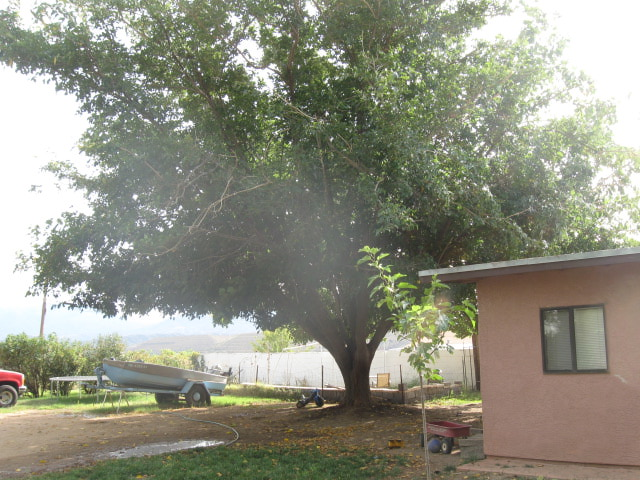Question
 male mulberry mat, sou
male mulberry mat, sou
I had two male mulberrys in my yard. A moth ago one blew down. The tree appeared rotten just under the ground. Now my big one (30-36") trunk is appears to be in the 1st stages of losing bark on the trunk. It looks like the trunk may be starting to crack verically in three spots. The tree is not bleeding. I am in southern AZ 3500 elevation. The tree is full of green leaves and seems ok other than this. I will try to attache pictures. Thank You, Mat
AnswerDear Mat, Sorry for the late response, but I thought your question was going to be easier to answer. I ended up double checking a number of sources because I want to be sure to include all the possibilities. First, let me say that your mulberry is gorgeous, and I do hope it will be ok. I do notice some dieback in the tree, but that is normal and is very common in older trees. There are, however, several things that COULD be wrong with your tree. The tree could be just getting old and starting to wear out. It is debatable how old a mulberry tree will live; the fruiting ones live much longer than the fruitless mulberry which only lives for about 25-40 years, but the fruiting ones may live only 100 or 150 years. It is hard to say how old your tree is, but it could be getting fairly old. I suspect that the drought from the last year or two is the major culprit. Mulberries have shallow root systems and therefore when there is not much water from the sky, they don't have a deep tap root to reach underground reservoirs. The drought has killed a lot of trees outright, but many more will die off in stages, and your tree may be one of those. If this is the case, making sure that you provide a slow deep watering every few weeks now, and perhaps as often as every week or two in the summer months will help to prevent any more damage. The other possible problem could be that it is suffering from a bacterial disease, in which you might have to contact a local professional. (Try a local university biology department if you have something with symptoms, or bring them pictures or a piece of damaged bark and you may not need to pay for this. You can also try the county extension service in your area). I must admit though, that my gut reaction is that this may be the beginning of the end. The tree being cracked but not bleeding means that you DON'T have borers, but that could be from drought. Or the tree could be just old and developing some character. The bark falling off is more worrisome. If you see any small bugs under the loose bark then spray with Spinosad and that should kill them off. You should probably remove any VERY LOOSE bark, but if the bark loss goes all the way around the tree, that is known as girdling, and that means that the tree will die, so we don't want that to happen. I'm sorry that there is no way to definitively diagnose your tree, but this should give you a pretty good guide. Oh, one other thing, if the water pools up around the tree after a rain and doesn't drain, then that is probably the problem, and you need to dig a few small trenches to drain the water away. I mention that because the ground under the tree does appear to be pretty compacted and flat. If it seems very compacted, you could go through the area with a pitchfork and make holes in the ground to help aerate the soil. That can sometimes be very effective. I hope this information helps, but don't hesitate to write back if you have more questions. Oh one more thing. If the tree is dying, I would simply do the best you can for it with these suggestions, and keep enjoying it until it becomes a hazard. Good luck, Melissa






